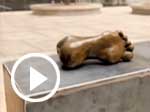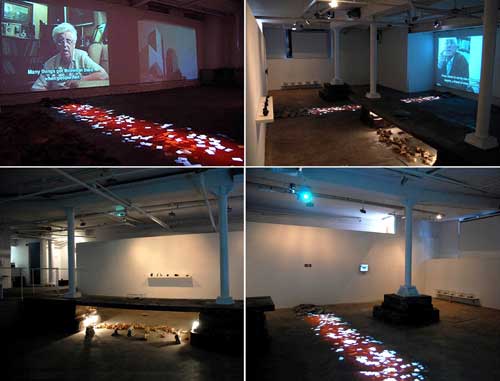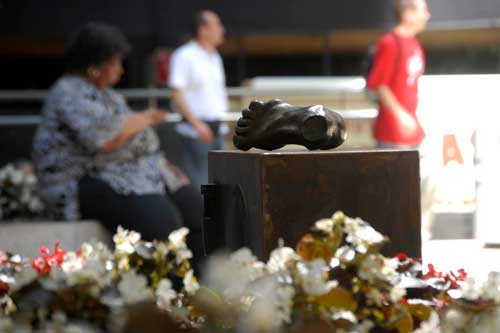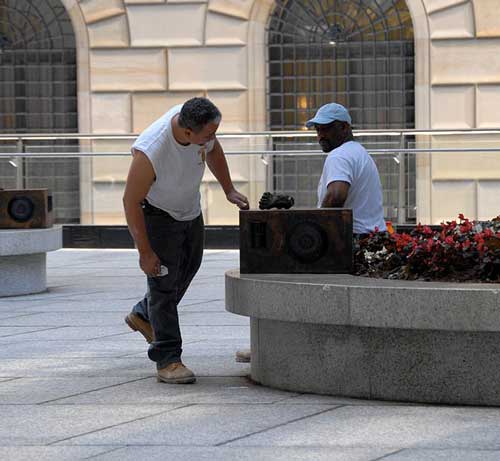

by Dr JANET McKENZIE
In the west there are two episodes of such magnitude and lasting devastation that stand out in the past 70 years: those of the bombing of Gernika, the Basque town on 26 April, in 1937, which killed 1,650 innocent people there; and the terrorist attack on the Twin Towers of the World Trade Center in New York, on September 11, 2001. Both were seemingly random acts of violence in peacetime; the victims innocent people going about their daily lives. These devastating events form the nexus on which the New York artist Anita Glesta based an important body of work, exhibited first in NYC at White Box and then by the Lower Manhattan Cultural Council at Chase Manhattan Plaza, three blocks from Ground Zero in New York, as part of their 18-month exploration on the theme of Amnesia: the Spectral life of cities (2007) that looked at aspects of urban life that are forgotten, invisible or obscured in the present. The relationships between memory and memorialisation, survival and loss and the manner in which these issues have been expressed through art historically underpin Glesta’s work.
Born and raised in New York from a Russian/Polish Jewish family, Glesta sees herself as wholly a New Yorker but with deep links to European history; in addition, she spent part of her teenage years in Northern Spain in the 1970s so feels an affinity for the experience of political turmoil there, and the legacy of Gernika. Her series of sculptures entitled Gernika/Guernica2 (2007) commemorate the 70th anniversary of the horrific attack on Gernika by Nazi Germany ordered by President Franco. The town of Gernika has been actively involved in the ongoing commemoration of the event, since the vast and powerful work Guernica (1937), by Pablo Picasso, which immortalised the tragedy, becoming perhaps the most significant anti-war artwork of the 20th century. Painted in black and white to allude to reportage and the lifelessness of war, the vast work measuring 3.5 x 7.8 metres was commissioned for the Paris International Exposition, by the Spanish government in exile during the Spanish Civil War. On Monday 26 April 1937, a market day in the then Basque capital, the German air force carried out what was ironically termed “a practice air attack” using explosive bombs, incendiary bombs and machine gunfire from low-flying aircraft against individuals on the ground in the town; some 1,650 people were killed and 900 injured. The devastating impact on innocent civilians was given an iconic status by Picasso’s poignant and powerful work.
Anita Glesta’s artistic career straddles two worlds: an intensely personal body of work that can be seen to belong to or informed by a humanist tradition: Francisco Goya, Käthe Kollwitz, to the existential despair expressed by sculptors such as diverse as Alberto Giacometti or the profound female sensibility of Eva Hesse. In addition Glesta makes site-specific works in public spaces. The works themselves vary from the elegant and appealing commission for the US Federal Census Building (2008) to the challenging works for Guernica/Gernika: eight bronze sound-sculptures in the shape of antique radios. On to each of these an element of Picasso’s iconic Guernica painting – a bronze foot or hand – is placed. A motion sensor when activated plays an audio recording of testimony from a survivor of the Gernika bombing. At White Box in New York (April–May 2007) she showed Gernika/Guernica: Desde El Cielo Hasta El Fondo (Hell Castings from Heaven), a multi-media installation using projection, installation, and documentary interviews. The juxtaposition of actual taped testimonies of the bombing with images of Picasso’s monumental work sought to challenge the ambivalence of history, and to question the blurred nature of reality versus fiction through contemporary media and the film industry. When Glesta ran to collect her two sons from their school beneath the Twin Towers, she implored, “This is not a movie”, fearful that such horror might not be comprehensible by children as reality.
From my bedroom window on the 32nd floor across the street from the World Trade Center I watched as the first plane struck the building on September 11. I ran to save my children from the school, which was beneath the towers, trying to shelter them from the horror of what they were seeing as we fled up West Street. A few months later, while we shifted around the city in various apartments, since our apartment downtown was contaminated. I kept thinking of my personal experience of living in Northern Spain as a teenager in the 1970s. I thought about Picasso’s great painting and what it meant to be making art in these terrible times, particularly in the context of a memorial, but in general what it means to make images of atrocity when it so surrounds us … I wrote an anonymous letter to gernika.com and received a response the following day from Maria Oinaguren, the director of The Peace Organisation in Gernika, who said: “We have been waiting for you.”3
Over the next five years Glesta made about a dozen visits to Gernika where she identified similarities to her own experience in 2001. She describes the memories of the elderly residents as “sacred truths” having a universal application, prompting her to incorporate the recordings into her sculptures. There is a consistent harmony between Glesta’s choice of material and method and her subject, for as a consummate technician she works tirelessly to find a visual lexicon that is appropriate to her task. Her work ranges from Gernika project, which 9/11 prompted her to embark on, to more private ambiguous works that give voice to the unspoken nuances of suffering and loss. By working in the Basque village of Gernika with the elderly survivors of the catastrophe Glesta effectively relocated the trauma of 9/11, to a place where historic perspective had been established and where a number of artists had addressed (and continue to address) the event in order to decipher the ramifications of such an atrocity. In his artistic confrontation of the Basque atrocity, Picasso created one of the greatest anti-war paintings in history. More recently sculptor Eduardo Chillida created the monumental, Our Father's House (1988) and the following year Henry Moore’s Large Figure in a Shelter (1990) was erected beside it. Overlapping with Anita Glesta was American-born artist William Kelly, whose Gernika work Studio International reviewed (William Kelly: Artist as Peacemaker) in 2008.
Glesta harnesses the subjective voice-as-witness to assuage a trauma deeply felt by those directly hit, and a world numbed by disbelief. The historic case of Gernika can be seen to play a similar role to that of the Jewish Museum in Berlin by Daniel Libeskind, when he came to design the Ground Zero monument, existing as it does for him in the nexus of the Holocaust and 9/11. By giving voice to the elderly survivors of Gernika endows gravitas to trauma that has to be endured for a lifetime. But Glesta’s work also pays homage to their courage and survival, thus informing her New York monument with hope. As a woman artist her body of work enabled her to act (unintentionally) as testament to the precarious journey that a mother embarks upon in the wake of such a catastrophe as she did in actuality on 9/11. Her ongoing art practice indeed has become a metaphor for the meticulous attention and love required by all parents to enable their children to navigate, in the most sensitive way, a path to a safer place. Like the mother and child relationship, explicitly rendered by Käthe Kollwitz, Anita Glesta’s works are almighty pleas for peace and reconciliation.
Glesta’s lexicon as an artist has undergone change, in particular the fact that she now works in media such as video that she pointed out to Elisabeth Sussman in conversation, she would not have considered years ago4. The use of resin in parts of her Gernika project conjures the visceral immediacy of the Eva Hesse works that broke new ground in their ability to convey an individual’s confrontation of mortality.
In contrast to the Gernika/Guernica works, Anita Glesta has designed a number of site-specific artworks for public places. Last year (2010) she completed a remarkable landscape installation project in the seven-acre surrounds of the US Census Bureau. An unlikely patron, the Census Bureau is supported by the National Art in Architecture Program of the US General Services Administration (GSA). It continues the longstanding support tradition of site-specific art works involving numerous artists of distinction who have over the years, been involved in the creation or embellishment of significant civic spaces, representing key federal aspirations and displaying a due altruism to national ethics and values. Glesta’s project was six years in the making, an “artistic meditation on the idea of counting and numeric order with a global perspective.” She explains:
I like to create a kind of environment … where people feel they are participants in this environment. So, very often they include a participatory touch or feel or something that includes the viewer to transform just the observation of a visual art into something that’s larger than that.
I’ve never worked with data, per se, but I do work with history and memory. I’ve addressed the notion of census and what that has meant for humans on this planet, all the way back to the Sumerians and the Romans … people were always using the census to count the crops, count each other, or know who is crossing their borders. So my way of addressing this is not in terms of data but using numerical symbols that represent the history of humans and particularly the ethnic diversity of this country.5
The Census Bureau in most countries has connotations of Orwellian images of digital cloning yet Glesta became excited by the project and followed a course that inevitably set out a lighter spectrum of site-specific insertions within a garden landscape. It ran a silvery, benign filament of numerical symbols (but not of numerological confusion), which crossed a field with paths of direct access and repose, an ambience, an ambulatory route even, of access for all ages. In the pathway, wells, benches, and sculptural mounds configure an appropriate template for number insertions, which lie or stand within. Numerical systems such as those of the Arabs, Ethiopians, Mayans, Persians and Chinese were incorporated by the artist with Native American numeric traditions, not well known to the public. In her research she found that in the 1880s a group of south-western Native Americans used bundles of twigs for census workers to denote their numbers. “The Native American people gave bundles of twigs to the census takers. Some [of the twigs] were forked in the end, and those represented the women, and some were small, and some were old. And that was their way of describing the members of the family.”6
Wondering what became of this data she questioned notions of personhood, especially those who exist on the fringes of society. Writer and artist Carol Schwarzman instinctively understands Glesta’s work, which she describes in Between Earth and Sky (2009): “She is interested in the scale of the human body in relation to both natural and cultural landscapes, the need for intimacy and the land, and the notion that a public presence of human form denotes community, serving as temporal continuity and the source of storytelling. Her projects presuppose that such proto-narratives can inspire viewers to interact with issues of authenticity, awareness, denial, and, ultimately, integrity.”7
I actually was very interested in doing this project because I felt that I had an opportunity to speak as an artist about counting the under counted in the United States, and drawing attention to who is the population of this country. So, it was really great to think about the census in a humane way and to hope … and I do believe from the sense I got from the census … that counting the people right now in 2010 can make a difference to this country … to know who are becoming the new profile of this ever-changing nation.8
A work that can be seen to link works as outwardly diverse as Gernika/Guernica (2007) and Census Walk (2004–10) is Pedazos (In Pieces) (2004). It links the creation of place, in Bed, Bath, Bird (1999) made in Australia, with references to historic events and the exploration of self. An intriguing work in terms of formal language and implied states of mind, Glesta here produces a most humane minimalism, yet it defies easy definition. After six years living and working in Australia Glesta and her family moved back to Manhattan, a year before 9/11. Pedazos was Glesta’s response to the events of September 11, 2001. It was constructed in the courtyard of Brooklyn’s Black and White Gallery. Constructed in the main part of hundreds of hand cast concrete tablets, three ramps led towards the sky, which became a blue ceiling in relation to a river made from cement. Existing as an entity between wholeness and disintegration, the loosely installed tablets shifted and crunched underfoot. Interspersed were resin ovoids, stained red or containing wriggling threads, that implied dualities and dialectic. Elisabeth Sussman draws a distinction between the road created by Minimalist sculptor Carl Andre (“a road that doesn’t reveal itself at any point or from any point”) and Glesta’s organic creation.
Like Andre, Glesta has conceived of sculpture as a horizontal surface on which to travel. But unlike Andre, Glesta imbues the simple horizontal structure of her sculpture with a concern for the relation between art and place, for space and material and for space and biological life and human presence. If for Andre, sculpture is a road, then for Glesta, the horizontal structure can be described as a path, with all the differences that implies.9
The artist explains:
Making, ordering and shattering durable substances and setting them beside transparent and ethereal substances becomes the gray area where words are limited. These blocks of concrete are meant to be experienced viscerally.
While they are of hard substance, there is an alchemical process to all of the materials I have used. Every block morphs from a powdery substance or liquid into a solid form overnight. Every hand-cast block or object in the installation contains elements of distilled emotion.
For PEDAZOS, transparent resins and the construction and deconstruction of concrete are my vehicles to continue my exploration of the power of biology, the mysterious and immeasurable human construction that is intuition.10
This, an alchemical practice, can be seen to share certain motives with Australian artist Janet Laurence, with whom Glesta became close friends in Sydney. (A Letter From Sydney: July 2010, Studio International)
Late in 2008 Glesta took up a residency at the Liguria Study Center in Bogliasco, Italy. There she began a series of video works based on Masaccio’s Expulsion from the Garden of Eden, in the Brancassi Chapel. Glesta’s Expulsion (2009) harnesses the fluidity of movement in the performance of dancer/choreographer Vanessa Justice, which in turn is echoed by abundant growth (oranges become forbidden fruit) and menacing snakes (morphed from artichokes). Schwarzman sums up Expulsion, and in doing so provides a key passage that links Pedazos with Glesta’s most recent works, Universe Untold (2011) and Lilith (2011):
The fluidity of video – and its basis in painting and sculpture – allows for a numinous visual poetry that transforms architectural space into a dialogue linking viewer, time, and place, connecting the Old Testament, early Renaissance, and today. Expulsion’s elegiac, rhythmic recording of Eden’s delights and the body’s central role in the story of lost paradise may be an attempt to find a balance between despair and hope – it is certainly a reckoning with nature.11
Haunting and beautiful, Universe Untold (2011) and Lilith (2011) are being completed as this essay is written. In conversation with Anita Glesta over the past months, her integrity and depth of purpose have shown themselves to be as natural to her as walking or breathing. Drawing from a number of complex but clear strands in her cultural heritage and her life experiences she has created in Universe Untold and Lilith, original and poignant portrayals of a present day heaven and hell. As complex works they make certain demands of the viewer yet they seek to enable individuals from all walks of life to take part. The video installation pulses with a primal existence, the pulsing of a foetal heart beat where bird imagery alludes to vulnerability, the balance of nature under threat, Judgment Day.
The Old Testament figure of Lilith is more significant in Midrashic literature (2nd Century) and the Kaballah (13th Century) than for biblical studies. As Adam’s first wife in the Book of Genesis, Lilith was insubordinate in sexual relations and thus deserted Adam, thereafter to be portrayed as “a winged female demon, who kills infants and endangers women in childbirth”, a “screech owl” or “night monster”.12 Her demonic characteristics can be understood as the personification of unseen forces and inexplicable events in real life. The Kabbalah enhances her demonic profile by partnering her with Satan as the queen of evil, a sexual temptress and thus the enemy of family and community. That history should demonise a woman as the personification of licentiousness and lust brings in to focus gender issues as a further source of conflict and repression worldwide.
Lilith and Universe Unknown were started before 9/11. Most recently images of the Japanese Tsunami and earthquake converged in her studio practice, prompting the realisation that she was in fact creating Hell. In Glesta’s Lilith, the tablets from Pedazos are reconstructed as wells from which she creates four structures. The biblical “well” is replete with meaning: to search for a well is to search for knowledge, as a source of water (fountain) it denotes Truth; an empty well connotes the desert, or spiritual wilderness, fabricated doctrines. In Glesta’s vocabulary the well refers to drawing from a deep source, from under the ground (deep in one’s consciousness/history) in contrast with human folly, superficiality and inevitable destruction. The dancer in Expulsion represented Lilith, and the same footage is projected anew in the well, drawing on the universal imagery and meaning of the Old Testament, itself central to the history of western art, with contemporary issues that range from terrorism, environment catastrophe, and the manner in which the artist today should respond to such issues in conceptual and formal terms; the personal enabling contemporary authenticity.
I extracted her from it and put her angst like movements into one of the wells so she is the Lilith in this piece now. Another well has a woman at the bottom somersaulting and standing on her head, the other very tall well has a man who looks a bit satanic and who just stares up from the bottom – occasionally opening and closing his eyes. The fourth well alternates between fire (flames) and another Lilith who is moving on her side engulfed by the flames. In this work, one is invited to climb on the concrete paver ruins to peer into the wells. There are also projected flames appearing darting on the concrete pieces on the outside of the structures engulfing at times what is an oval cast concrete form which suggests a head.13
Universe Untold is a plea for redemption. Cast latex body parts, a chicken foot, a heart and bird images all represent the artist’s lexicon of hope. Birds are central to Glesta’s imagery:
I have sculpted them in clay for many years and cast them in latex as well as concrete and in bronze. In this work I have suspended some of them and then made animations of them, I videoed the sculptures that I made by moving them like puppets (by hand). I then drew over them so they are all drawn by me. Everything in all these works and most of my work in fact, has my hand in it. Not in a metaphoric sense but literally. I make everything: I sculpt, draw, paint, edit, build, and do the sound myself.
I happened to have been making it right next to the “earthquake” work of concrete with the bodies that are trapped beneath. I realised there was an exuberance in this piece, that counters in a sense, the weight and oppression of the other work. In a way, I felt I was making a heaven alongside hell. This dialectic is not unusual for me and I felt relieved that this piece seemed to form itself so optimistically.14
Universe Untold has connotations of vulnerability and the delicate balance of nature, where the application of female strengths in the vital roles of procreation and nurturing can be used to refer to qualia, “a kind of question about our biology, the neurons that make us respond to our environment and the question of who we are in the universe. The body parts which I use, as well as the sounds, human heart and bird sounds with a choral of human voices and bells every once in a while, are really a kind of exaltation which is in opposition to the sense of entrapment of our life on earth”.15 In her meticulous attention to historic research and her commitment to a better world Anita Glesta creates an art that transcends cultural constraints, takes into account estranged individuals and shattered communities pulling them as tiny but vital elements of an inclusive and redemptive art.
References
1. Peter Read, Returning to Nothing: The Meaning of Lost Places, Cambridge University Press, 1996: 101–111.
2. Guernica is the Spanish spelling, used by Picasso; Gernika is the Basque and correct modern usage
3. Anita Glesta, Foreword, Gernika/Guernica, Desde de Cielo, Hasta el Fondo (Hell Castings from Heaven), Anita Glesta, White Box, New York, 2007.
4. Anita Glesta interviewed by Whitney Curator Elisabeth Sussman about her installation "PUTTI FOR SARA" and her other work at a NYFA sponsored evening January 2010.
5. Hrag Vartanian, “Census Art: Anita Glesta Reflects on the History of Counting”. June 17, 2010 www.hyperallergic.com
7. Carol Schwarzman, Between Earth and Sky. Sculpture, 55, Washington DC, November 2009.
9. Elisabeth Sussman, Anita Glesta, Black and White Gallery, Brooklyn, New York, 31 October 2003 – 2 February 2004.
12. Christopher Witcombe, Images of Women in Ancient Art: Issues of Interpretation and Identity, Virginia, 2000.
13. Anita Glesta, interview with Janet McKenzie, 31 April, 2011




